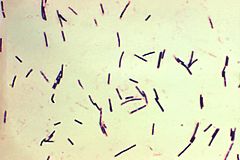Clostridium perfringens facts for kids
Quick facts for kids Clostridium perfringens |
|
|---|---|
 |
|
| Photomicrograph of Clostridium perfringens | |
| Scientific classification | |
| Kingdom: | |
| Phylum: | |
| Class: | |
| Order: | |
| Family: |
Clostridiaceae
|
| Genus: | |
| Species: |
C. perfringens
|
| Binomial name | |
| Clostridium perfringens Veillon & Zuber 1898
Hauduroy et al. 1937 |
|
Clostridium perfringens (say: klos-TRID-ee-um per-FRIN-jenz) is a tiny living thing called a bacterium. It belongs to a group of bacteria known as Clostridium. This type of bacteria is found almost everywhere in nature. You can find it in decaying plants, in the dirt, and even in the guts of humans and animals.
Sometimes, C. perfringens can cause problems for people, like making them sick. Other times, it can be present without causing any harm at all.
Contents
What is Clostridium perfringens?
Clostridium perfringens is a type of gram-positive bacterium. This means it has a special cell wall that stains purple in a lab test called a Gram stain. It is also an anaerobe, which means it can grow and live without needing oxygen. This is why it thrives in places like deep soil or inside the intestines.
Tiny Living Things: Bacteria
Bacteria are single-celled organisms that are too small to see without a microscope. They are found all around us and even inside us. Some bacteria are helpful, like those that help us digest food. Others can cause diseases. C. perfringens is one of those bacteria that can sometimes cause illness.
Where does C. perfringens live?
This bacterium is very common in many different environments. It is found in the soil all over the world. It also lives in marine sediment, which is the mud and sand at the bottom of the ocean.
Finding it Everywhere
C. perfringens is also a normal part of the intestinal tract (the gut) of many living things. This includes humans, other vertebrate animals (like cows and chickens), and even insects. Because it's so widespread, it can easily get into our food and water.
How can C. perfringens affect people?
While C. perfringens is common, it can sometimes cause a type of food poisoning. This happens when people eat food that contains a lot of these bacteria, especially if the food was not cooked or stored properly.
Food Poisoning: A Common Problem
When C. perfringens causes food poisoning, it usually leads to symptoms like stomach cramps and diarrhea. These symptoms often start about 6 to 24 hours after eating the contaminated food. Luckily, this type of food poisoning is usually mild and goes away on its own within a day or two. It is rarely serious.
Staying Safe: Prevention Tips
To prevent illness from C. perfringens, it is important to follow good food safety rules.
- Cook food thoroughly: Make sure meat, especially beef and poultry, is cooked all the way through.
- Keep food hot: If you are serving food, keep it at a safe hot temperature (above 60°C or 140°F).
- Chill food quickly: Leftovers should be put in the refrigerator within two hours after cooking.
- Reheat food properly: When reheating leftovers, make sure they are steaming hot all the way through.
Following these simple steps can help keep you safe from C. perfringens and other foodborne illnesses.
See also

- In Spanish: Clostridium perfringens para niños

